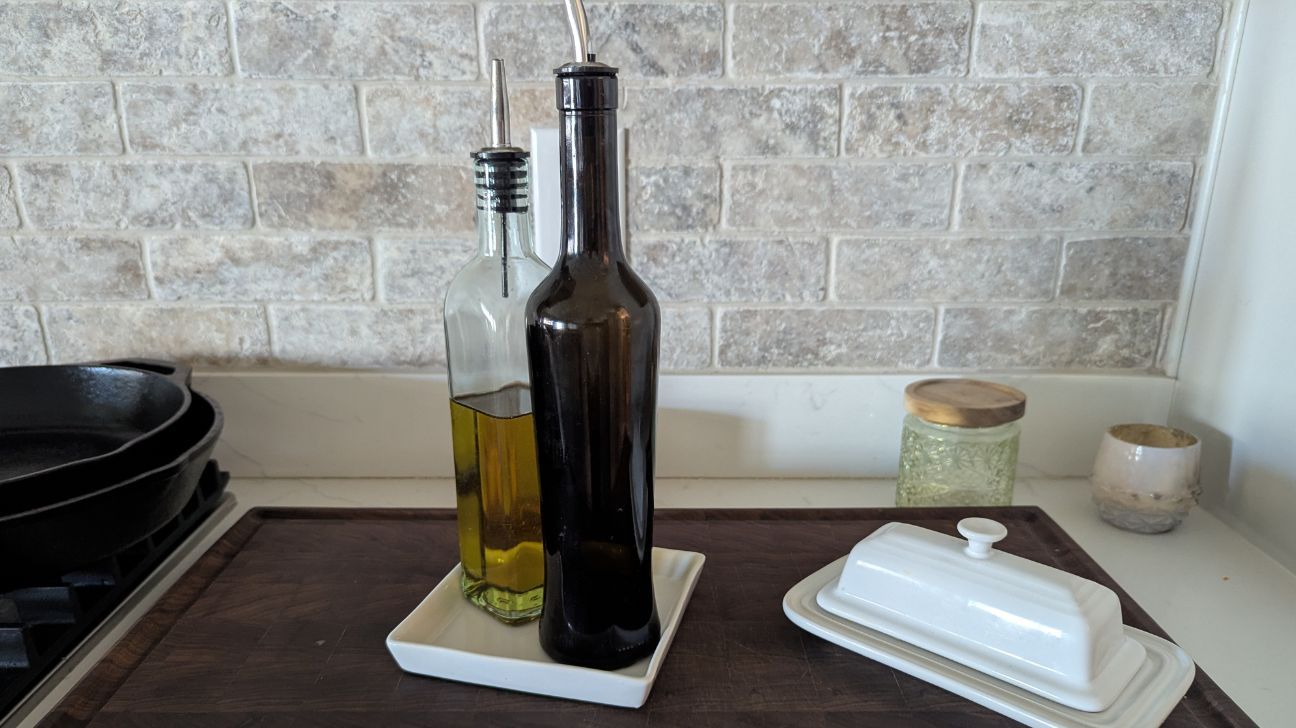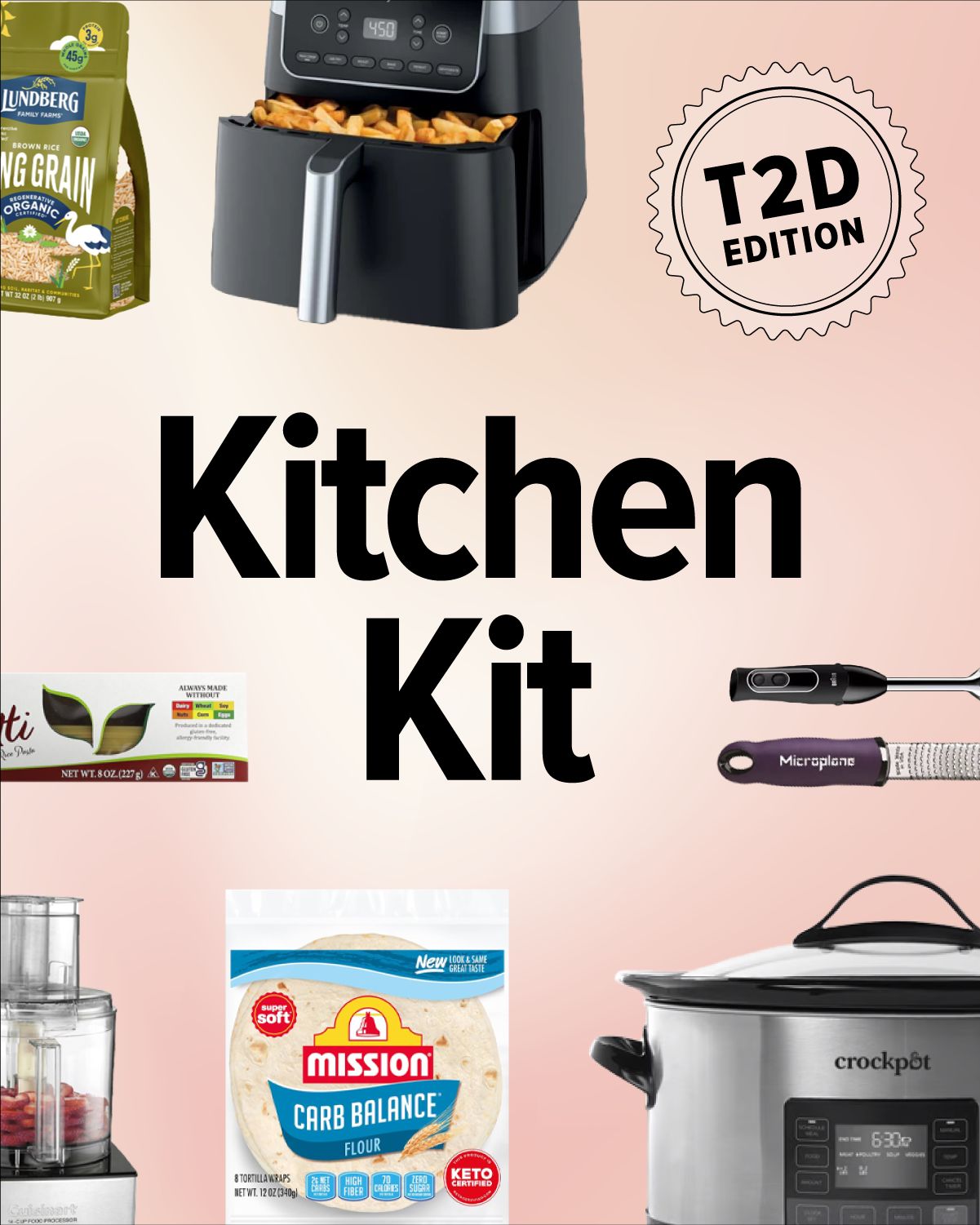Healthy eating for diabetes doesn’t have to be all rules, no fun. With the help of a dietitian, here’s how we recommend setting up your kitchen.
Eating for type 2 diabetes comes down to a few themes. Fewer carbs, yes. Less saturated fat, yes. More fiber, whole grains — yes and yes. With all that in mind, one of the most effective ways to evolve your diet is to minimize overly processed foods and eating out. That means, yes, cooking from home more often.
But this isn’t about being super restrictive. No eating plan ever works in the long term if you’re not satisfying your taste buds. We have a few thoughts on how to set up a healthy kitchen without sacrificing flavor.

You may be thinking, “I get it — use olive oil instead of butter.” But today’s social media landscape has led to a lot of confusing information about which oils and fats are actually the best.
For example, ghee, tallow, and grass-fed butter all have newfound fan clubs — and it’s not without reason. They contain healthy omega-3s. Ghee and tallow have higher smoke points. And they’re all major flavor boosters for vegetables. But these oils are also high in saturated fat.
“While I wouldn’t recommend making any of them your primary cooking fat, they can certainly have a place in a diabetes-friendly kitchen when used in moderation,” said Kelli McGrane, MS, RD.
If cooking with ghee or tallow means you’re likely to consume more vegetables to replace processed foods in your diet, then it may be a good move for you.
As it often does, this comes down to finding balance. You can adopt a similar mindset toward other oils — like canola oil, vegetable oil, and seed oils — that are labeled by many as bad for your health.
According to McGrane, “The actual significance of these oils on your health largely depends on how much you’re consuming and how you’re consuming them. For example, when drizzled over a salad or otherwise incorporated into a generally healthy diet in small amounts, these oils are unlikely to have negative consequences for your health.”
Canola oil specifically has been linked to
That said, consuming large amounts of seed oils through commercially fried and ultra-processed foods could result in increased levels of inflammation and a higher risk of certain chronic diseases.
Product picks
They do exist, they do, they do! You can take a few different approaches to pasta.
“If pasta is a staple in your diet, consider buying versions that are higher in protein and fiber or less highly processed,” said McGrane.
She suggested quinoa-, chickpea-, and lentil-based pasta. When we tested pasta alternatives, we found one brown rice option by Now Foods that was a close dupe to regular noodles in terms of taste.
Generally speaking, brown rice is higher in fiber than white rice, so it better supports a gradual rise in blood sugar. Plus, according to McGrane, it also has more antioxidants and B vitamins.
You can cook rice in broth instead of water to add extra flavor.
Last note on pasta: Cook it al dente. According to McGrane, this makes the pasta harder to digest and may cause a lower rise in blood sugar levels than overcooked pasta.
When it comes to taco night, most major grocery stores carry low carb, diabetes-friendly tortillas. McGrane advised looking for options with 30 grams of carbs or less and at least 3 grams of fiber. You can also stock tortillas made from whole grains, corn, almond flour, or coconut flour as alternatives.
Product picks
Invest money and space in the appliances that make cooking easier — and the ones you’ll actually use.
Some people may find a multicooker like an Instant Pot helpful, but many have bought one only to watch it take up kitchen space while they consistently bypass it for their slow cooker. It’s OK to stick to the basics and use what you already have.
“First consider the types of recipes you enjoy the most,” said McGrane. “If you’re trying to cut back on fried foods, an air fryer could be a good investment and an easy way to get that satisfying crunch with fewer calories and grams of fat.”
If finding time to cook is an issue, a slow cooker can add a lot of variety to the meals you cook without adding a bunch of tedious steps. McGrane suggested breakfast casseroles, steel-cut oatmeal, and veggie-filled soups.
There’s one other appliance McGrane has found to be a workhorse, speaking less as a dietitian and more as a busy single mom of two — her food processor.
“It’s the MVP of my kitchen, helping me shred vegetables quickly, pulse together homemade granola bars, and whip up yogurt-based dips,” she said.
The only downside is that the good food processors (the ones that tend to work really well and actually make cooking breezier) are pricey.
Product picks
Let’s face it — half the battle of wanting to eat more vegetables is how to make them flavorful and not mushy. An air fryer can help avoid mushiness (see the previous section), but the right seasonings can also make vegetables more appealing to the taste buds, even if you’ve just never been a veggie lover.
And salt is not the only way to season. For example, you can use a microplane to zest lemon and other citrus. (Did you know it’s more flavorful than the juice?) You can also use a zester to grate garlic and ginger, which add flavor.
If you’re new to cooking at home, McGrane recommended adding a couple of sodium-free seasoning blends to your next grocery haul. They are convenient, and you can use them in many different dishes.
Similarly, sauces and condiments are flavor bombs for otherwise plain foods.
“If it tastes good with meat, chances are the sauce will be just as tasty with veggies,” said McGrane.
Just know that many store-bought sauces tend to contain a lot of sugar. They are trickier (but not impossible) to find in diabetes-friendly formulas.
One solution is to experiment with making your own. Using an immersion blender to puree all the ingredients can help simplify that process.
Product picks
A few other tips you might want to try include:
- Be wary of “low fat” or “fat-free” labels on condiments, dressings, and sauces: While this sounds like a good thing, it can also mean lots of added sugar. This applies to various dairy products, too. McGrane said, “While nonfat products are popular for people trying to lose weight, these products are often sweetened and may not be as satisfying.”
- Don’t get stuck on the fats: McGrane said it’s generally recommended to limit fat intake to 20% to 30% of total calories, but it’s most important to prioritize getting enough omega-3s throughout the week and limiting saturated fat intake to no more than 10% of calories.
- Try keeping packaged snacks to 2 grams of added sugar per serving: You don’t have to avoid the middle grocery aisles altogether. Just be wary of sugar content per serving, as well as serving size on the packaged goods.
- Don’t be afraid of the frozen aisle: While you may not want to stockpile from the ice cream aisle, buying frozen produce instead of fresh ones can save money and still offer nutritional value.
Consider meal delivery services to get you started
We’ve tested just about every meal delivery service, and these are our picks as the best for diabetes.
The most straightforward tip is to be frugal with carbohydrates, but not everyone needs a fully low carb diet. For some, a moderate approach works best when limiting carbs. The goal is to manage insulin spikes, not to feel starved.
And the same rule applies to the rest of your diabetes meal planning. Aside from monitoring your carbs:
- Diversify your plate with nutrient-dense produce that is beneficial for diabetes, like dark leafy greens, broccolini, peaches, cherries, apples, and berries.
- Deprioritize saturated fats and food with lots of sugar or sodium.
- Make sure you’re eating fiber with each meal.
- Eat grains (whole grains are ideal), but watch portion sizes and pair with fiber and healthy fats to minimize their effect on blood sugar levels.
There is no exact science, as this is highly personal to your unique health scenario. But generally speaking, it should feature whole grains and minimally processed foods. Canned legumes and vegetables without added sodium are also common staples.
McGrane recommended grabbing from the produce sections for a diabetes-friendly kitchen:
- dark leafy greens
- broccolini or broccoli
- carrots
- cucumbers
- bell peppers
- berries
- apples
- cherries
- peaches
- avocados
If you feel overwhelmed by how to set up your kitchen and what to buy for diabetes-friendly cooking, pick one swap at a time to explore.
Less is often more when it comes to tools, ingredients, and appliances you keep in your kitchen.





